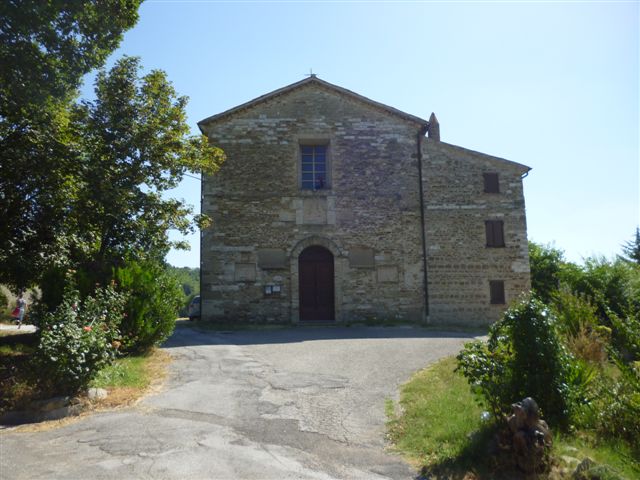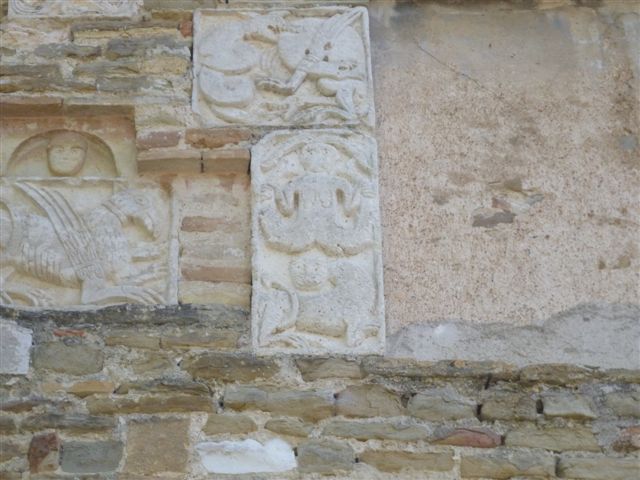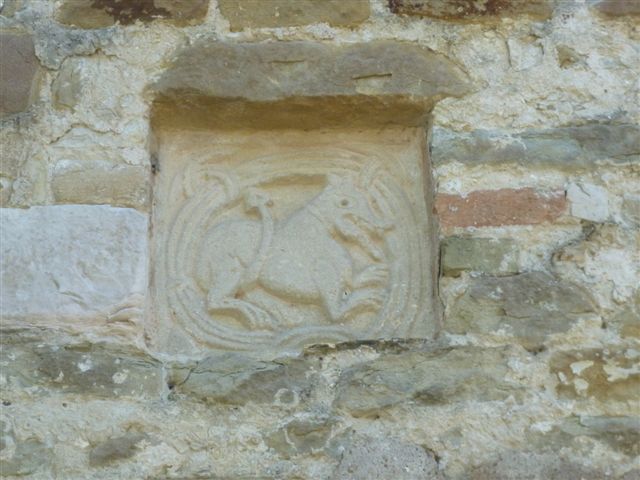We’re going to resume our much-interrupted journey along the valley of the River Cesáno and the Roman road which runs alongside it. We’ve already visited the ruined Roman town of Suasa, on the other side of the river, and the Romanesque churches of San Lorenzo in Campo and San Gervasio di Bulgaria.
A bit of history for those who are interested
After Suasa was abandoned following the fall of the Roman Empire, there was no administrative centre in the Cesano valley. In the early Middle Ages, the monasteries of San Lorenzo and San Gervasio (both tenth century), plus San Vito (around the year 1000), Madonna del Piano (S Maria in Portuno, tenth century), San Biagio in Serra Sant’ Abbondio (1000 AD), of which only the churches survive, and the still-existing monastery of Fonte Avellana, formed a close network, which took over the administration and organisation of the surrounding countryside and its settlements. There is a good website, http://santamariainportuno.it/ (which is why I haven’t yet posted about Madonna del Piano), which contains this information, which I originally got from a lecture at the church. It also has photos of details of the interiors of the churches, http://santamariainportuno.it/monasteri_val_cesano but doesn’t identify them. If, having read this post, you have a look at the photos, you will be able to tell where at least one of them comes from.
Back to San Vito
Fortunately, from my point of view, some of these churches have retained something of their mediaeval character. My followers will know that the one-size-fits-all Baroque church renovations of the seventeenth and eighteenth centuries leave me cold. Luckily for lovers of the Romanesque, though perhaps unfortunately for the churches, lack of money or remoteness has preserved them from the worst excesses of restoration. The eleventh-century San Vito church,  the one I visited most recently, is known as “La Pieve Romanica” or “La Pieve Antica”(“The Romanesque parish church” or “The old parish church”). By the way, for those who didn’t know, the word “pieve” derives from “plebs”, the Latin for “common people”. According to the comune’s website, the church ceiling fell in in the earthquake of 3 June 1781, it contains a fine picture of Mary of the Sorrows, and has been declared a national monument and recently restored. Shame it’s kept locked. As the book “Santa Maria in Portuno nella valle del Cesano”(Bologna, 2006) says, “the capitals, sculptures and paintings contained within the churches of the Cesano valley wait only to be discovered” (p.41, my translation). That was written eight years ago and,they are still waiting, never to be discovered unless some agreement can be reached about keyholders.
the one I visited most recently, is known as “La Pieve Romanica” or “La Pieve Antica”(“The Romanesque parish church” or “The old parish church”). By the way, for those who didn’t know, the word “pieve” derives from “plebs”, the Latin for “common people”. According to the comune’s website, the church ceiling fell in in the earthquake of 3 June 1781, it contains a fine picture of Mary of the Sorrows, and has been declared a national monument and recently restored. Shame it’s kept locked. As the book “Santa Maria in Portuno nella valle del Cesano”(Bologna, 2006) says, “the capitals, sculptures and paintings contained within the churches of the Cesano valley wait only to be discovered” (p.41, my translation). That was written eight years ago and,they are still waiting, never to be discovered unless some agreement can be reached about keyholders.
Half a mile from the main centre of population, the church offers infrequent services, for the benefit of a dedicated small group which obviously really loves it. As I mentioned above, it is usually locked without any indication of a keyholder. I didn’t want to go along and join in one of the services, just as a way of seeing the interior. Perhaps next time I’ll venture to disturb the inhabitants of the house built on to the church .
It is the sculptures on the outside of the church which are really fascinating and are worth the journey. According to the book cited above, they have probably been re-used from elsewhere.
The upper carving, in the lower plaque on the right, represents a two-tailed mermaid, but otherwise I don’t know what they represent, either in themselves or as allegedly Christian allegories. If any reader happens to know, please tell us via the comments facility.
There is something pagan, wild and primitive about them which is reminiscent of Wiligelmo’s Duomo at Modena. The interlaced pattern on the left of the upper photograph above is reminiscent of Celtic craftsmanship. Maybe they are embarrassing to the modern Church hierarchy, as I can find little written about them and they are certainly not as well-known as they deserve to be. They are not mentioned on San Lorenzo in Campo’s website (San Vito is a part of the comune of San Lorenzo). There is a large and unsightly gap, over the porch, where one sculpture has been removed, or window blocked up?
Next stop Serra Sant’ Abbondio!






Pingback: The Englishwoman explores the Romanesque church...